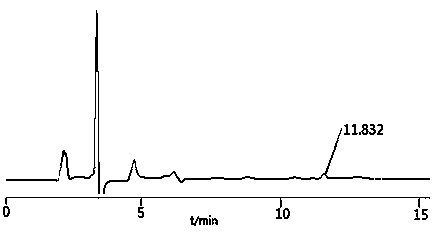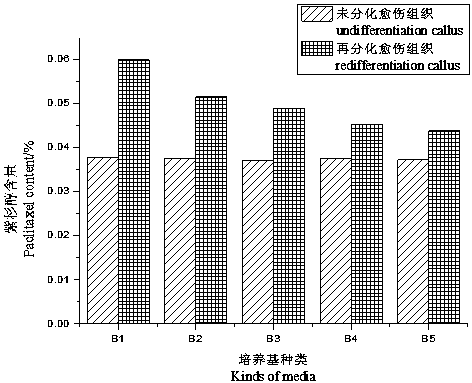Induced redifferentiation method for improving paclitaxel content in calluses of Taxus wallichiana var. mairei
A southern yew, callus technology, applied in horticultural methods, botanical equipment and methods, plant regeneration, etc., can solve the problems of not being widely used in commercialization, restricting the commercial application of technology, and metabolic genetic instability.
- Summary
- Abstract
- Description
- Claims
- Application Information
AI Technical Summary
Problems solved by technology
Method used
Image
Examples
Embodiment 1
[0045] (1) Explant pretreatment: take mature young stems of Taxus chinensis in the same year, cut off the leaves, rinse with tap water for 2-4 hours, dry the surface water, cut into small sections about 5 cm long, and place them in a triangular flask. Soak in 75% alcohol for 15 s in the ultra-clean workbench, then wash with 0.1% HgCl 2 Soak for 20 min, rinse with sterile water for 6-8 times, and then aseptically cut into 0.5-1 cm long pieces for inoculation.
[0046] (2) Callus induction culture: Aseptically inoculate stem segments in MS medium supplemented with 1.2mg / L 2,4-D, 4mg / L NAA, and 2.8mg / L 6-BA for induction culture; culture conditions All were cultivated in artificial climate chambers, with temperature (20±5) ℃, humidity (80±5)% dark and temperature (25±5) ℃, humidity (85±5)%, light 1000-1200 Lx respectively 12 h alternately.
[0047] (3) Subculture of callus: In step (2), after induction of yellow-green callus, the yellow-green callus was transferred to supplemen...
Embodiment 2
[0055] (1) Explant pretreatment: take mature young stems of Taxus chinensis in the same year, cut off the leaves, rinse with tap water for 2-4 hours, dry the surface water, cut into small sections about 5 cm long, and place them in a triangular flask. Soak in 75% alcohol for 15 s in an ultra-clean workbench, then soak in 0.1% HgCl2 for 20 min, rinse with sterile water 6-8 times, and cut into 0.5-1 cm long pieces for inoculation.
[0056] (2) Callus induction culture: Stem segments were aseptically inoculated in MS medium supplemented with 1 mg / L 2,4-D, 3 mg / L NAA, and 2 mg / L 6-BA for induction culture; the culture conditions were Cultivated in an artificial climate box, with temperature (20±5) ℃, humidity (80±5)% dark and temperature (25±5) ℃, humidity (85±5)%, light 1000-1200 Lx for 12 h each process alternately.
[0057] (3) Subculture of callus: In step (2), after induction of yellow-green callus, the yellow-green callus was transferred to supplemented with 1.5 mg / L 2,4-D,...
Embodiment 3
[0065] (1) Explant pretreatment: take mature young stems of Taxus chinensis in the same year, cut off the leaves, rinse with tap water for 2-4 hours, dry the surface water, cut into small sections about 5 cm long, and place them in a triangular flask. Soak in 75% alcohol for 15 s in an ultra-clean workbench, then soak in 0.1% HgCl2 for 20 min, rinse with sterile water 6-8 times, and cut into 0.5-1 cm long pieces for inoculation.
[0066] (2) Callus induction culture: Stem segments were aseptically inoculated in MS medium supplemented with 1.5 mg / L 2,4-D, 5 mg / L NAA, and 3 mg / L 6-BA for induction culture; the culture conditions were For culturing in an artificial climate box, and temperature (20±5) ℃, humidity (80±5)% dark and temperature (25±5) ℃, humidity (85±5)%, light 1000-1200 Lx each 12 h alternately.
[0067](3) Subculture of callus: In step (2), after induction of yellow-green callus, the yellow-green callus was transferred to supplemented with 2.0 mg / L 2,4-D, 4 mg / L ...
PUM
 Login to View More
Login to View More Abstract
Description
Claims
Application Information
 Login to View More
Login to View More - R&D
- Intellectual Property
- Life Sciences
- Materials
- Tech Scout
- Unparalleled Data Quality
- Higher Quality Content
- 60% Fewer Hallucinations
Browse by: Latest US Patents, China's latest patents, Technical Efficacy Thesaurus, Application Domain, Technology Topic, Popular Technical Reports.
© 2025 PatSnap. All rights reserved.Legal|Privacy policy|Modern Slavery Act Transparency Statement|Sitemap|About US| Contact US: help@patsnap.com



